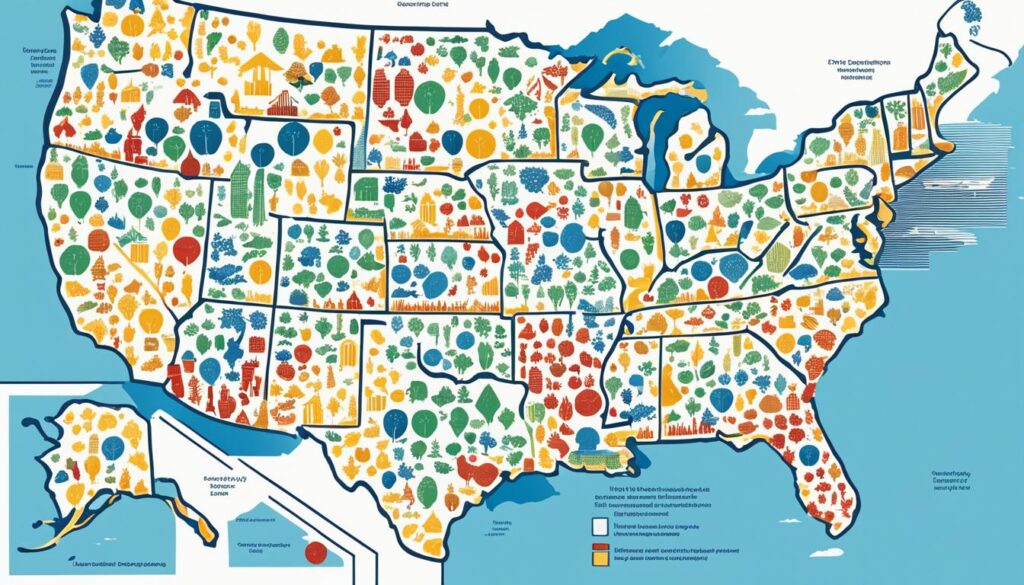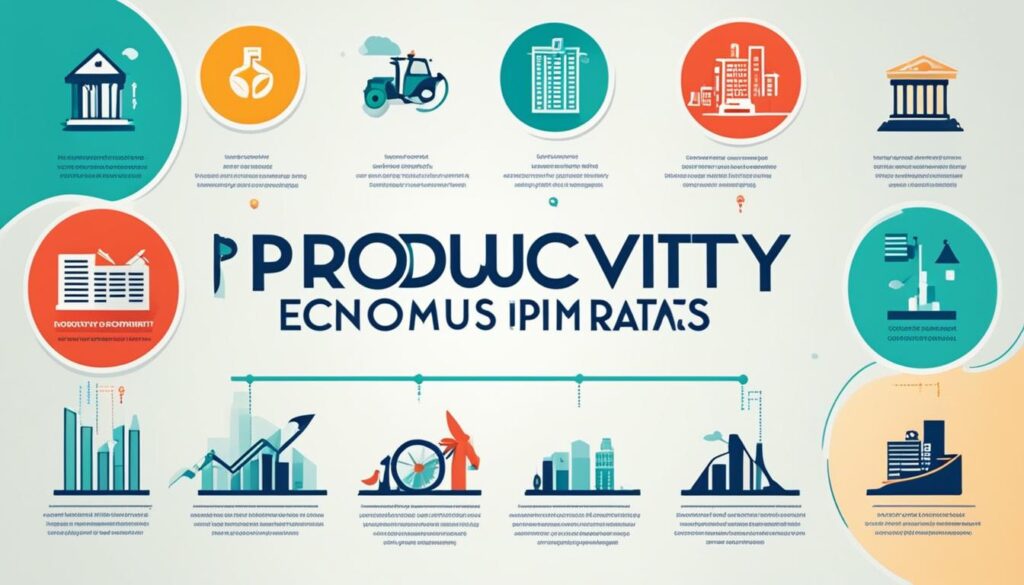Boost US Productivity, GDP & Employment Growth

Have you ever wondered why the productivity growth in the United States has slowed down despite technological advancements? And how can we reignite it to fuel economic growth and create more jobs?
In the past 15 years, productivity growth has stagnated in the US, averaging just 1.4 percent. This trend is not unique to the United States but is observed in most OECD countries. The link between productivity growth and real incomes has also weakened, leaving many workers discouraged and hindered income growth. So, what can be done to reverse this trend and unleash the true potential of the US economy?
In this article, we will explore the factors contributing to the slowdown in productivity growth and delve into strategies to enhance workforce efficiency. We will also examine the disparities that exist among different states and sectors and how they impact overall productivity. Additionally, we will discuss the potential of generative AI in driving productivity growth and its anticipated impact on global GDP.
Join us on this journey to discover how we can boost US productivity, GDP, and employment growth, and shape a brighter future for our economy.
Key Takeaways:
- US productivity growth has slowed down to an average of just 1.4 percent in the past 15 years.
- The link between productivity growth and real incomes has weakened, hindering income growth.
- There are significant disparities in productivity among different states and sectors in the United States.
- Generative AI has the potential to drive productivity growth and automation of work tasks.
- Achieving higher productivity growth is crucial for the overall economic well-being of the country.
The State of Productivity in the United States and OECD Countries.
In the past decade, the United States and most OECD countries have been facing a significant challenge in productivity growth. Despite the remarkable advancements in technology, the average productivity growth in the United States has been limited to just 1.4 percent. This trend is not unique to the United States alone, but is also observed in other OECD member countries, indicating a broader issue that needs to be addressed.
The link between productivity growth and real income has weakened, as real incomes are growing at a slower pace compared to productivity gains. This imbalance raises concerns about the overall economic well-being of individuals and the potential for societal progress. Additionally, labor participation rates have been declining, showing a decline in worker engagement and indicating the need for revitalization.
These trends highlight the urgent need to identify and address the underlying factors that are contributing to the slowdown in productivity growth in the United States and OECD countries. It is essential to explore strategies and implement productivity enhancement tools that will help boost GDP growth, increase employment opportunities, and create a more robust economic development platform.
Enhancing workforce efficiency and boosting national productivity are integral to driving economic growth and creating a strong foundation for sustainable development. By embracing innovative approaches and leveraging productivity-enhancing technologies, we can empower our workforce and enhance productivity levels across different sectors and states.
Now, let’s take a closer look at the disparities in productivity among states and analyze the sectoral differences that contribute to the overall productivity landscape.

Detailed Analysis of Revenue Trends in the United States and OECD Countries:
| Year | United States | OECDCountries |
|---|---|---|
| 2010 | 2.1% | 1.8% |
| 2011 | 1.8% | 1.7% |
| 2012 | 1.6% | 1.5% |
| 2013 | 1.5% | 1.3% |
| 2014 | 1.4% | 1.2% |
Productivity Disparities among States.
In the United States, there exists a significant disparity in productivity levels and growth among different states. Currently, seven states stand out as leaders in terms of productivity growth: California, Colorado, Massachusetts, New York, North Dakota, Texas, and Washington.
These states not only boast higher productivity levels but also exhibit faster productivity growth rates compared to the national average. On the other hand, 25 states are lagging behind, with below-average productivity levels and slower-than-average growth. Interestingly, this group includes several inland states to the east of the Mississippi River.
While some states benefit from a favorable mix of sectors contributing to their higher productivity, it is important to note that the variation in productivity levels and growth is primarily driven by differences within sectors rather than the composition of sectors themselves.
To bridge the productivity gap among states, it is imperative to create an enabling environment that supports productivity growth across all sectors and industries. By implementing effective productivity enhancement tools and strategies, along with an economic development platform focused on boosting national productivity, we can drive economic growth and elevate the overall workforce productivity in the United States.

Productivity Levels and Growth in Select States
| State | Productivity Level | Productivity Growth |
|---|---|---|
| California | High | Faster than national average |
| Colorado | High | Faster than national average |
| Massachusetts | High | Faster than national average |
| New York | High | Faster than national average |
| North Dakota | High | Faster than national average |
| Texas | High | Faster than national average |
| Washington | High | Faster than national average |
| Other States | Below-average | Slower-than-average |
Key Takeaways
- California, Colorado, Massachusetts, New York, North Dakota, Texas, and Washington lead in productivity growth.
- 25 states lag behind in terms of productivity levels and growth.
- Variation in productivity is driven by differences within sectors rather than the composition of sectors.
- Creating an enabling environment is crucial to bridge the productivity gap among states.
Sectoral Differences in Productivity.
Productivity levels and growth play a pivotal role in the economic development of the United States. However, these productivity dynamics vary significantly across different sectors. While some sectors have embraced digital technology and witnessed remarkable productivity gains, others have lagged behind due to limited transformation. Sectors such as healthcare, food, and agriculture have not fully capitalized on technological advancements, resulting in slower productivity growth.
It is important to note that these differences in productivity levels and growth are not solely dependent on the overall sector mix within states. Within each sector, there exist variations that contribute to the productivity gap between leading and lagging states. Notably, industries such as retail, accommodation, and transportation display significant disparities in productivity between states.
In order to drive productivity and boost the overall economic growth, it is crucial to foster an environment that enables firms to thrive across all sectors. By implementing productivity-enhancing strategies and leveraging technological advancements, businesses can overcome sector-specific challenges and enhance their workforce efficiency.
Productivity Variation within Industries
The variation in productivity levels and growth is not limited to sectors as a whole. Within specific industries, there exist significant differences that offer valuable insights. By analyzing these variations, policymakers and industry leaders can identify areas for improvement and develop targeted strategies to enhance productivity.
For instance, let’s consider the retail industry. Leading states within the retail sector have demonstrated significantly higher productivity levels compared to lagging states. This points to the presence of internal factors within states that drive productivity growth. By addressing these factors and implementing measures to support productivity, lagging states can bridge the gap and create a more balanced productivity landscape within the industry.
To further illustrate this point, let’s take a look at the transportation industry. The difference in productivity levels between leading and lagging states within this industry showcases the importance of factors such as infrastructure, logistics, and technology adoption. Investing in the necessary infrastructure and adopting innovative technologies can significantly boost productivity in lagging states, driving economic growth.

By addressing the sectoral differences in productivity and implementing strategies to enhance productivity within industries, the United States can unleash its full economic potential. Fostering a culture of innovation, investing in technology, and providing support to businesses across all sectors will pave the way for sustained productivity growth and drive economic development.
| Industry | Leading States | Lagging States |
|---|---|---|
| Retail | California, New York | Mississippi, West Virginia |
| Accommodation | Nevada, Hawaii | Wyoming, Delaware |
| Transportation | Texas, Illinois | Montana, Arkansas |
The Role of Generative AI in Productivity Growth.
Generative artificial intelligence (AI) holds immense potential to drive productivity growth and revolutionize the automation of work tasks. With AI’s capacity to automate approximately 25% of labor tasks in advanced economies and 10-20% in emerging economies, industries worldwide are eagerly exploring its possibilities. However, while some predict a seismic shift in productivity growth propelled by AI, it is essential to approach these claims with caution, as transformative outcomes may still be premature.
Currently, generative AI predominantly contributes to efficiency gains by automating less complex tasks. This empowers workers to redirect their efforts towards more productive activities, magnifying their impact on the overall productivity spectrum. However, as AI technologies continue to evolve, their potential to substantially influence productivity growth in critical sectors becomes increasingly apparent.
AI’s Impact on Healthcare
One sector where generative AI is poised to make significant strides is healthcare. By leveraging AI algorithms, healthcare providers can enhance patient care and streamline workflow processes. For example, AI-powered supportive tools for radiologists can facilitate the detection of anomalies in medical scans, leading to faster and more accurate diagnoses. Moreover, AI’s predictive analytics capabilities enable healthcare professionals to identify high-risk patients and intervene with proactive care accordingly. These advancements not only improve patient outcomes but also optimize resource allocation, ultimately boosting productivity within the healthcare industry.
AI’s Contribution to Drug Discovery
The field of drug discovery is another area where AI shows immense promise. AI algorithms can efficiently analyze vast amounts of biomedical data, accelerating the identification and development of new drugs. By employing machine learning techniques, AI can identify patterns and correlations within complex datasets, leading to more targeted and efficient drug discovery processes. This expedites the development of life-saving medications, driving productivity within the pharmaceutical industry while bringing essential treatments to patients faster.
AI’s Role in Cybersecurity
In the realm of cybersecurity, AI plays a vital role in identifying and mitigating potential threats. Its machine learning capabilities enable AI systems to monitor network activities, rapidly detect suspicious patterns, and respond proactively to potential breaches. By automating these security tasks, AI enhances workforce efficiency, allowing cybersecurity professionals to focus on more strategic and critical aspects of their roles. This not only bolsters an organization’s security measures but also minimizes the potential impact of cyber threats on overall productivity.
AI in Design and Software Development
Generative AI is also revolutionizing the design and software development processes. Through AI-powered tools, designers can automate repetitive design tasks, enabling them to focus on more innovative and creative aspects. This enhances workflow efficiency and expedites the design iteration process. Similarly, AI-assisted software development streamlines code generation and optimization, expediting application development without compromising quality. By augmenting these critical areas, generative AI drives productivity gains within the design and software development industries.
As generative AI continues to advance and evolve, its impact on productivity growth is expected to become more profound. While caution should be exercised in making lofty predictions, the transformative potential of AI in sectors such as healthcare, drug discovery, cybersecurity, design, and software development is indisputable. By embracing and harnessing the power of generative AI, industries can unlock new realms of productivity, fuel innovation, and drive economic growth on a national scale.
The Impact of AI on Global GDP.
AI has the potential to revolutionize global GDP growth, creating new opportunities and driving economic development. According to Goldman Sachs Research, the implementation of AI technology could have a significant impact on productivity and ultimately boost GDP.

Goldman Sachs Research predicts that the United States could experience a remarkable increase of 1.5 percentage points in productivity growth annually over a 10-year period as a result of AI integration. This significant rise in productivity would have a direct positive effect on GDP, contributing to economic growth and enhancing workforce efficiency. Similar effects are anticipated in other major developed markets.
While the impact of AI on emerging economies may be somewhat smaller due to higher employment in sectors with low AI exposure, the potential for growth and development remains significant. The ultimate size of these effects depends on the continued development and implementation of AI technologies, as well as their capability to transform businesses and rescale the workforce.
| Country/Region | Potential Increase in Productivity Growth |
|---|---|
| United States | 1.5 percentage points annually |
| Other major developed markets | Comparable effects to the United States |
| Most emerging economies | 0.7-1.3 percentage points annually |
These estimates highlight the significant role that AI can play in driving economic growth and enhancing productivity on a global scale. By embracing AI as a powerful workforce productivity tool, countries can harness its potential to accelerate GDP growth, foster economic development, and create new employment opportunities.
Conclusion
Boosting productivity, GDP, and employment growth is crucial for the overall economic well-being of the United States. To address the slowdown in productivity, it is essential to create an enabling environment for productivity-enhancing tools and strategies. By adopting job creation software and economic development platforms, the country can enhance workforce efficiency and boost national productivity, driving economic growth.
Exploring the potential of generative AI to drive productivity growth and automation is another avenue to be considered. By leveraging AI technologies, businesses can increase their productivity levels and enhance workforce efficiency. This will lead to higher incomes, increased labor participation, and a stronger economy.
It is important for stakeholders, including business leaders and policymakers, to collaborate and implement relevant policies that support workforce development and the adoption of productivity enhancement tools. By working together, the United States can regain its historical rates of productivity growth, stimulating GDP, and employment growth. This will pave the way for a prosperous future, where the benefits of increased productivity are shared by all.






